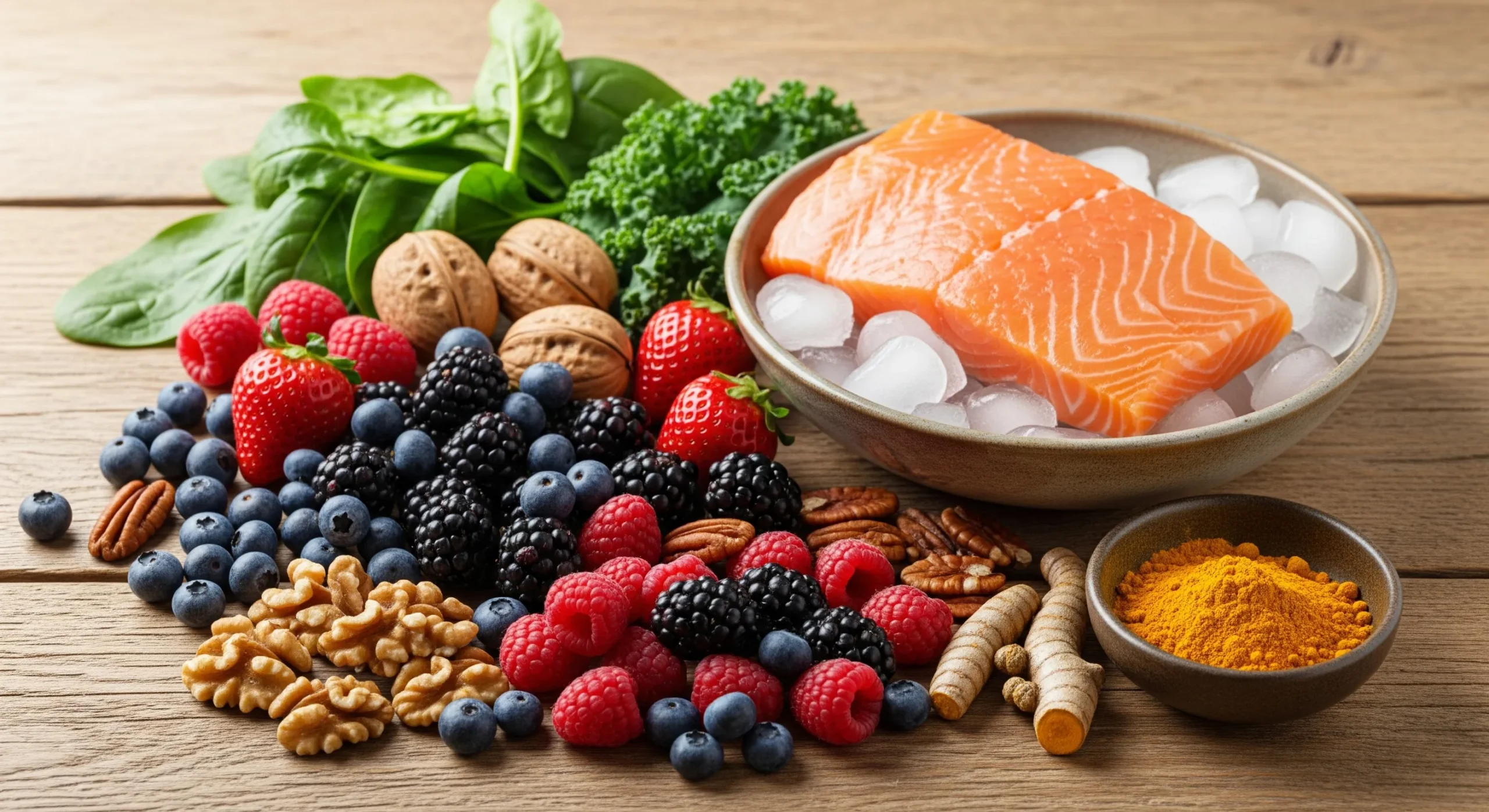10 Powerful Anti-Inflammatory Foods You Should Eat

You know that nagging stiffness in your joints after a long day? Or the bloating that just doesn’t go away? That’s often inflammation talking. Now, not all inflammation is bad. Our bodies need it to heal. But when it lingers, it quietly wreaks havoc on everything—our heart, gut, brain, and even our mood.
I’ve been down that road. I remember waking up with sore knees in my early 30s and thinking, “This can’t be normal.” It turned out to be chronic inflammation, and my doctor’s advice wasn’t just medicine—it was food. That’s right. Real, everyday food helped me feel better than any over-the-counter pill ever could.
Today, I’m sharing 10 powerful anti-inflammatory foods you should eat. They’ve not only helped me personally, but they’re backed by loads of science. And the best part? They’re delicious, affordable, and likely already in your kitchen.
Let’s dig in.
1. Turmeric – The Golden Healer
If you’ve ever seen a curry that glows like sunshine, thank turmeric. This bold, yellow spice is one of the most potent anti-inflammatory foods you’ll find. The magic lies in curcumin, its active compound, which has been shown in studies to rival some anti-inflammatory drugs—without the side effects.
I started adding a pinch of turmeric to my morning tea after my mom swore by it. Within weeks, my bloating calmed down and my energy soared. You can mix it into soups, eggs, smoothies, or even golden milk.
Quick Tip: Combine turmeric with a pinch of black pepper. The piperine in pepper boosts curcumin absorption by up to 2,000%.
Why It Works:
| Nutrient | Benefit |
|---|---|
| Curcumin | Fights inflammation on a cellular level |
| Antioxidants | Neutralize harmful free radicals |
| Manganese | Supports metabolism and bone health |
Highlight: Turmeric is a powerhouse that helps reduce chronic inflammation from the inside out.
2. Blueberries – Small but Mighty
Blueberries are like tiny balls of health. Don’t let their size fool you. They’re bursting with antioxidants, especially anthocyanins, which help reduce oxidative stress and inflammation.
I snack on a handful every morning with Greek yogurt. Not only do they taste like candy, but they also help clear brain fog. Seriously, I feel sharper and more focused after including them regularly.
Fun Fact: Studies show that blueberries may reduce markers of inflammation, especially in people with metabolic syndrome.
Anti-Inflammatory Benefits:
-
Boost brain health
-
Lower blood pressure
-
Fight oxidative stress
Highlight: Blueberries are an easy, tasty way to keep your inflammation levels low and your mind sharp.
3. Salmon – Nature’s Omega-3 Gift
Growing up near the coast, we ate grilled salmon every Sunday. I didn’t know then that it was protecting our hearts and joints. Salmon is rich in omega-3 fatty acids, particularly EPA and DHA, both known for fighting inflammation in a big way.
The beauty of salmon lies in its versatility. You can bake it, grill it, or add it to salads. Plus, it leaves you feeling full and satisfied.
Pro Tip: Wild-caught salmon has higher omega-3 content compared to farmed ones.
Omega-3 Comparison (per 100g):
| Fish | EPA (mg) | DHA (mg) |
|---|---|---|
| Salmon (wild) | 500 | 1,200 |
| Tuna | 280 | 900 |
Highlight: Salmon is one of the best protein-rich anti-inflammatory foods you can eat.
4. Leafy Greens – The Silent Warriors
Spinach, kale, and arugula may not get you excited, but they’re silent warriors in the inflammation fight. They’re packed with vitamins A, C, K, and folate, all of which play a role in immune support and inflammation control.
When I started making green smoothies with spinach, I noticed my skin started glowing, and I stopped feeling sluggish. It’s like my body was finally getting what it needed.
Kitchen Hack: Toss greens into omelets, soups, or smoothies. You won’t even taste them.
Leafy Greens Nutrient Boost:
-
Vitamin K: Regulates inflammatory responses
-
Magnesium: Relaxes muscles and reduces stress-induced inflammation
Highlight: Leafy greens are nutrient-rich, low-calorie foods that fight inflammation from multiple angles.
5. Ginger – The Zesty Root
Ginger has been used for centuries in traditional medicine—and for good reason. It contains gingerol, a compound with powerful anti-inflammatory and antioxidant effects.
I love grating fresh ginger into my tea or stir-fry. It brings a kick of flavor and soothes the stomach like magic. When I feel achy or under the weather, ginger tea is my go-to remedy.
Try This: Brew a tea with ginger, lemon, and honey. It’s comforting, healing, and incredibly anti-inflammatory.
Ginger’s Perks:
-
Reduces joint pain and stiffness
-
Aids digestion
-
Lowers inflammatory markers like CRP (C-reactive protein)
Highlight: Ginger isn’t just for nausea—it’s a spicy, healing root that calms inflammation naturally.
6. Walnuts – Brain and Body Fuel
Walnuts aren’t just brain-shaped for fun. They’re loaded with alpha-linolenic acid (ALA), a plant-based omega-3 that reduces inflammation and supports cognitive function.
I keep a jar of walnuts at my desk for a midday snack. They keep my cravings in check and give my brain a little boost. I also sprinkle them over oatmeal or salads for a satisfying crunch.
Smart Swap: Replace croutons with walnuts in salads to lower inflammatory response and up your healthy fats.
Nutritional Table (per 1 oz):
| Nutrient | Amount |
|---|---|
| ALA Omega-3 | 2.5g |
| Protein | 4g |
| Fiber | 2g |
Highlight: Walnuts are an easy, satisfying snack that feeds both your body and your brain.
7. Olive Oil – Liquid Gold
There’s a reason Mediterranean diets are praised worldwide. A big part of that is extra virgin olive oil (EVOO). It’s loaded with oleocanthal, a compound that works similarly to ibuprofen in reducing inflammation.
Growing up, my grandmother would drizzle olive oil on everything—from bread to soup. She lived to 96. Coincidence? Maybe. But the science backs it up.
Best Use: Use EVOO raw—on salads, hummus, or veggies—for maximum benefits.
EVOO Perks:
-
Lowers inflammation-related enzymes
-
Supports heart health
-
Rich in monounsaturated fats
Highlight: Olive oil is a flavorful fat that’s as healing as it is tasty.
8. Garlic – The Immune Booster
Garlic is a bold flavor with even bolder benefits. It contains allicin, a sulfur compound that has anti-inflammatory and antimicrobial properties.
I remember as a kid, my mom crushing garlic cloves and mixing them with honey for colds. It worked every single time. Now I sauté garlic in almost every meal. It’s comforting and deeply nourishing.
Tip: Let chopped garlic sit for 10 minutes before cooking to activate allicin.
Garlic’s Healing Power:
-
Fights infections
-
Reduces blood pressure
-
Supports immune health and lowers inflammation
Highlight: Garlic is nature’s antibiotic with a powerful anti-inflammatory food punch.
9. Chia Seeds – Tiny Seeds, Huge Impact
Chia seeds may be small, but they pack a mighty punch. They’re rich in fiber, omega-3 fatty acids, and antioxidants, all of which help fight inflammation.
I toss them into smoothies or overnight oats. They swell up and form a gel-like texture, which helps with digestion and keeps you full longer.
Bonus: Just 2 tablespoons provide almost 5g of omega-3s.
Why Chia Rules:
-
Improves digestion
-
Fights chronic inflammation
-
Supports heart and skin health
Highlight: Chia seeds are tiny superfoods with massive anti-inflammatory benefits.
10. Tomatoes – Juicy and Healing
Tomatoes are rich in lycopene, an antioxidant that’s especially good at lowering inflammation in the lungs and other organs. When cooked, lycopene becomes even more available to the body.
I love slow-roasting tomatoes with garlic and herbs. The flavors intensify, and it turns into a soothing, hearty dish. Tomato soup is also a go-to comfort meal that feels like a warm hug on a cold day.
Try This: Pair tomatoes with olive oil to boost lycopene absorption.
Tomato Health Table:
| Nutrient | Benefit |
|---|---|
| Lycopene | Fights oxidative stress |
| Vitamin C | Strengthens immunity |
| Potassium | Regulates blood pressure |
Highlight: Tomatoes are tasty, versatile, and perfect for lowering inflammation in delicious ways.
Final Thoughts: Heal from the Inside Out
Inflammation doesn’t always scream for attention. Sometimes, it’s a quiet tiredness. Or a nagging ache. Or a fog you just can’t shake. The good news? You can fight back—with food.
These 10 powerful anti-inflammatory foods aren’t exotic or hard to find. They’re simple, accessible, and deeply healing. Adding just a few of them into your daily meals can make a big difference in how you feel.
So next time you’re choosing between chips and a handful of walnuts, or skipping breakfast instead of making a blueberry smoothie, remember—your body is listening.
